Unit 4 Do it yourself Period 4 Integrated skills& Study skills课件(共79张PPT)
文档属性
| 名称 | Unit 4 Do it yourself Period 4 Integrated skills& Study skills课件(共79张PPT) |

|
|
| 格式 | pptx | ||
| 文件大小 | 68.9MB | ||
| 资源类型 | 教案 | ||
| 版本资源 | 牛津译林版 | ||
| 科目 | 英语 | ||
| 更新时间 | 2023-07-30 14:14:06 | ||
图片预览


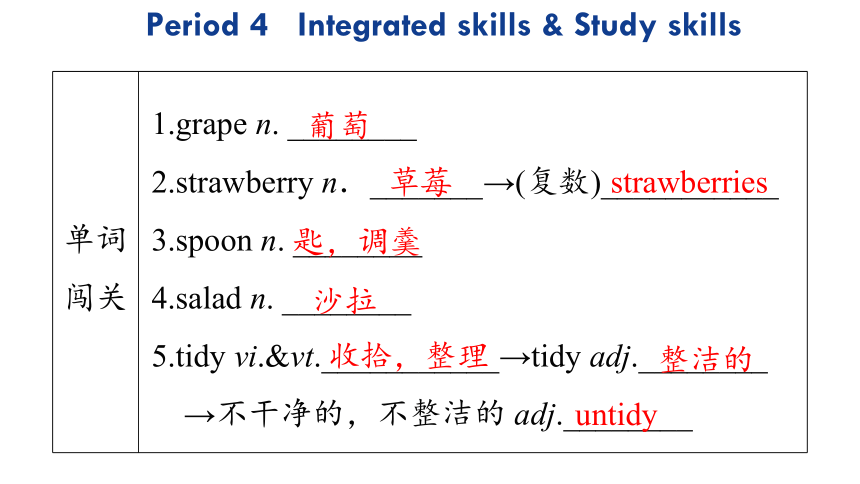
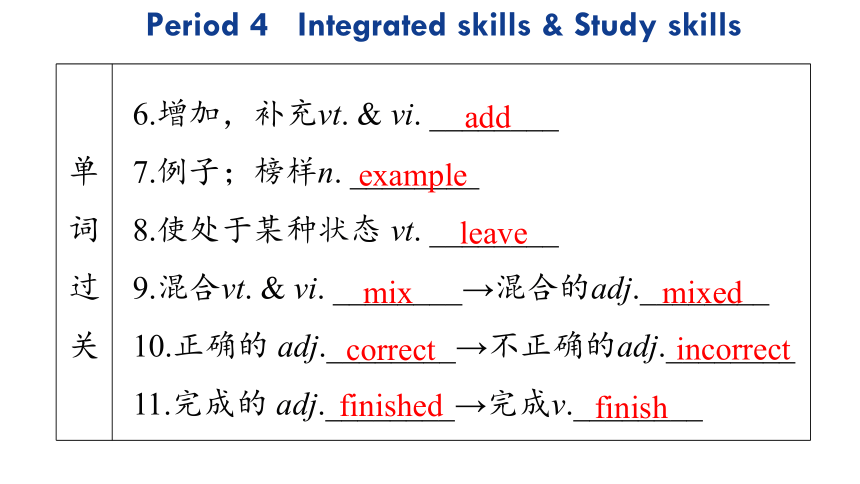
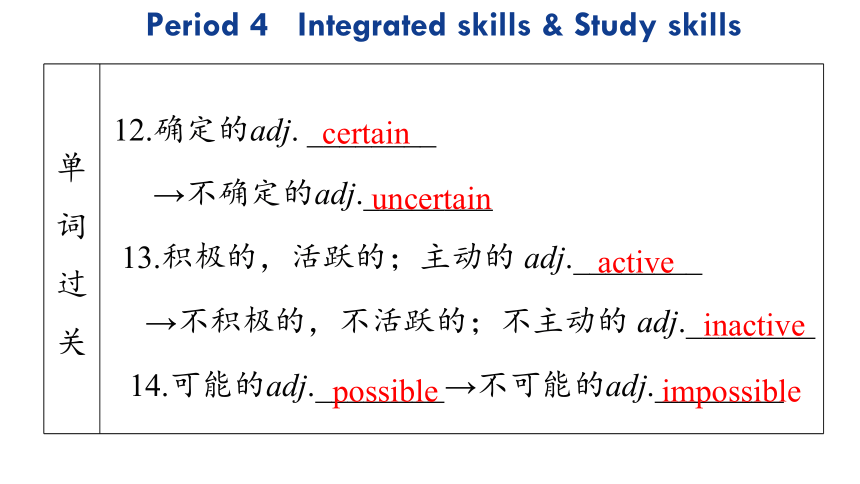

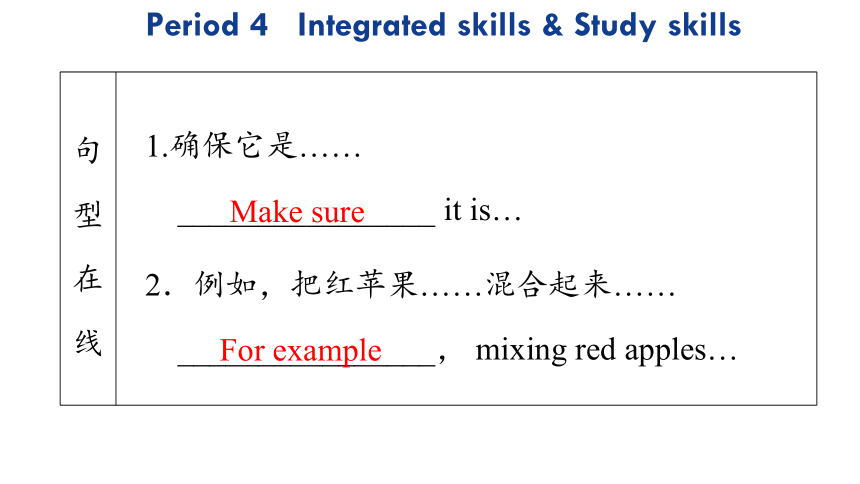


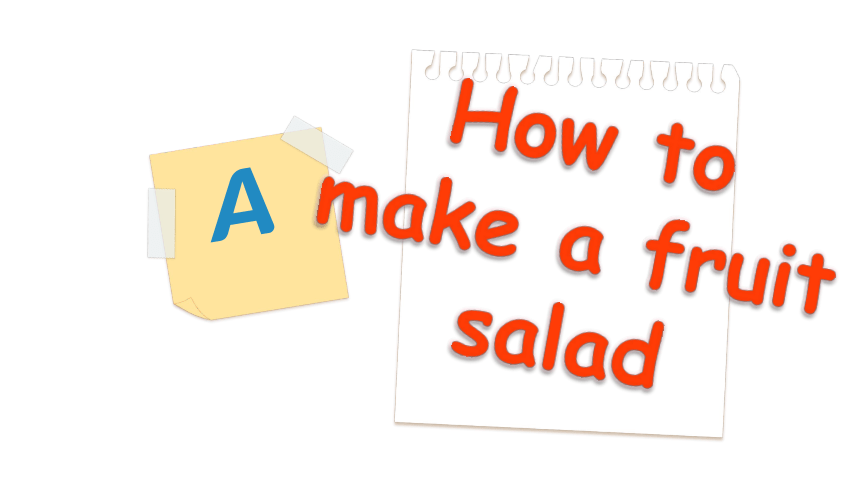
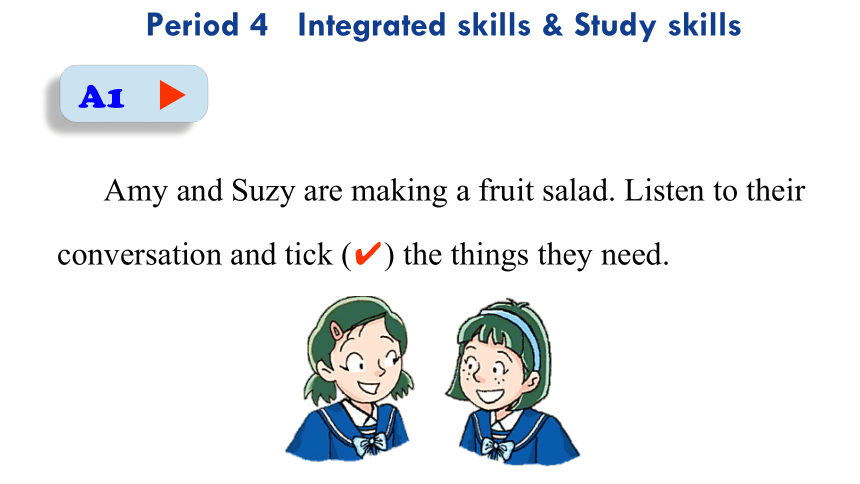
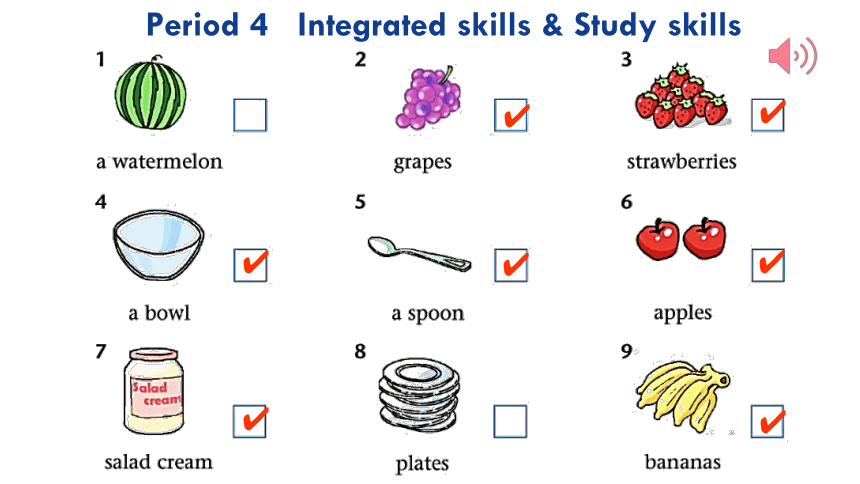
文档简介
(共79张PPT)
Period 4
Integrated skills & Study skills
课前自主预习
单词闯关 1.grape n. ________
2.strawberry n._______→(复数)___________
3.spoon n. ________
4.salad n. ________
5.tidy vi.&vt.___________→tidy adj.________
→不干净的,不整洁的 adj.________
untidy
葡萄
草莓
strawberries
匙,调羹
沙拉
收拾,整理
整洁的
单词过关 6.增加,补充vt. & vi. ________
7.例子;榜样n. ________
8.使处于某种状态 vt. ________
9.混合vt. & vi. ________→混合的adj.________
10.正确的 adj.________→不正确的adj.________
11.完成的 adj.________→完成v.________
add
example
leave
mix
mixed
correct
incorrect
finished
finish
单词过关 12.确定的adj. ________
→不确定的adj.________
13.积极的,活跃的;主动的 adj.________
→不积极的,不活跃的;不主动的 adj.________
14.可能的adj.________→不可能的adj.________
impossible
certain
uncertain
active
inactive
possible
短语互译 1.确保 ____________
2.例如 ____________
3.be able to ____________
4.tidy up ____________
收拾妥,整理好
make sure
for example
能够,会
句型在线 1.确保它是……
________________ it is…
2.例如,把红苹果……混合起来……
________________, mixing red apples…
Make sure
For example
句型在线 3.我们能停止打扫房屋并做一些食物吗?
Can we ________________ the house and make some food
4.我马上就收拾。
I′ll ________________ right now.
tidy up
stop cleaning
Integrated skills
How to make a fruit salad
A
A1
Amy and Suzy are making a fruit salad. Listen to their conversation and tick ( ) the things they need.
A2
Read Amy′s notes of how to make a fruit salad. Put her notes in the correct order. Write the numbers 1-4 in the boxes.
Wash the fruit.
Mix them together. Add some salad cream if you like .
Cut some of the larger fruit into small pieces .
Choose your favourite fruit.
1
2
3
4
A3
Listen to Suzy giving Amy some tips for making a fruit salad. Help Amy complete her notes with the correct words.
Tips for making a fruit salad
Choose your favourite fruit. Use fruit (1)_________. Make sure it is (2)__________.
Use fruit of (3)_______ colours and try to make your fruit salad look (4)__________ it tastes. For example,mixing red apples,green (5)_____,purple grapes and(6)______ together will make the salad look very colourful.
in season
fresh
different
as good as
pears
oranges
Prepare the fruit salad (7)______________ you are going to eat it. Some of the fruit will quickly (8)____________ when you leave it (9) _________ for some time.
just before
turn brown
in the air
Speak up: Let's make some sandwiches
B
Sandy and her mum are talking about what to eat for lunch. Work in pairs and talk about what you can make for lunch. Use the conversation below as a model.
Sandy:It′s time for lunch, Mum. Can we stop cleaning
the house and make some food I′m hungry.
Mum:OK. Let′s make some sandwiches.
Sandy:Are they quick and easy to
make
Mum:Sure. Look at me. First, pick a piece of bread.
Then put some tomato sauce on it.
Sandy:Next,we can put some ham and vegetables on it.
Mum:That′s correct.
Sandy:Is that all right
Mum:Well, just put another piece
of bread on top of it. Finished!
Study skills
The prefixes un-, in- and im-
A prefix is a letter or a group of letters that we add to the front of a word to form a new word. One of the most common prefixes for adjectives is un-. It means “not”. We add it to some adjectives to give them the opposite meaning.
certain uncertain
comfortable uncomfortable
important unimportant
interesting uninteresting
More examples:
able→unable
fair → unfair
friendly → unfriendly
happy → unhappy
healthy → unhealthy
kind → unkind
lucky → unlucky
pleasant → unpleasant
tidy → untidy
usual → unusual
We can also use some other prefixes, such as in- and im-, to form new words with opposite meaning.
active inactive
correct incorrect
patient impatient
possible impossible
More examples:
complete → incomplete
direct → indirect
polite → impolite
proper → improper
Read the conversations below. Add the correct prefixes to some of the adjectives so that all the sentences make sense.
1 Annie: Do you spend a lot of time doing outdoor
sports
Simon:Sure. It's usual for me to stay at home all day.
2 Sandy:Our neighbour next door is putting something
on the wall.
Mum: It′s possible to sleep with all that noise.
3 Millie:Do you know how to fix the bicycle, Andy
Andy:Sorry. I′m certain about how to do that.
4 Mum:Suzy,your room is really tidy—things are all
over the floor.
Suzy:Sorry,Mum. I′ll tidy up right now.
考点精讲
1 mix vt. & vi. 混合
[观察]
Mix them together. 把它们混合在一起。
Oil and water do not mix. 油和水不相融。
[拓展]
mix 的形容词形式为________,意为“混合的”。
[探究]
mix 既可作________动词,又可作________动词。
[搭配]
________________ 弄错,弄乱,混合,搅匀
________________ 把……和……混合起来
mix…with…
及物
不及物
mixed
mix up
活学活用
1.(1)你可以把鸡蛋和面粉混合在一起。
You can ________________ flour.
(2)________________(不要混淆) the two kinds of
vegetable seeds.
Don′t mix up
mix eggs with
2 add vt. & vi.增加,补充
[观察]
Add some salad cream if you like.
如果你喜欢,加点沙拉酱。
Please add some sugar. 请加些糖。
[探究]
add 作________动词时,后面直接接________。
[拓展]
________________把……加到……中
add…to…
及物
宾语
活学活用
2. 请往汤里加些盐。
Please ________ some salt ________ the soup.
to
add
3 leave vt. 使处于某种状态
[观察]
You′d better leave the door open.
你最好让门开着。
[探究]
leave意为“___________________”,常用于“leave+宾语+________________(形容词或介词短语等)”结构,表示“使……处于某种状态”。
宾语补足语
使处于某种状态
[拓展]
(1) leave用作_______,意为“离开,出发”,常用于以下结构:__________ 离开去某地;_____________ 离开某地去某地。
(2) leave用作动词,意为“留下;遗忘”。其固定结构:leave sth+介词+sp,表示“_________________”。
把某物遗忘在某地
动词
leave for sp
leave sp for sp
活学活用
3.(1) We′d better ________ when he is thinking,as
he prefers to solve problems on his own.
A.let him down B.cheer him up
C.leave him alone D.ring him up
C
【解析】考查动词短语辨析。let sb down意为“让某人失望”;cheer sb up意为“使某人精神振奋”;leave sb alone意为“随某人去;让某人独自待着”,该短语为“leave+宾语+形容词/介词短语”的结构,意为“使……处于某种状态”;ring sb up 意为“打电话给某人”。句意为“当他思考问题的时候,我们最好还是________,因为他更喜欢独立解决问题”,故答案为C。
(2)—Jack,remember ________ off the lights when
________ the home.
—OK,I won′t forget,Mum.
A.turning;leaving B.to turn;leave
C.turning;left D.to turn; leaving
D
【解析】考查非谓语动词。句意:“杰克,离开家时别忘了关灯。”“好的,我不会忘记的,妈妈。” remember to do sth 意为“记得去做某事”,符合语境,故排除A、C;主语you和动词leave是主动关系,表示正在发生,故用现在分词。故选D。
4 number of students 学生的数量
[观察]
Who can give me a correct answer
谁能给我一个正确的答案?
Do you think his answer is correct
你认为他的答案正确吗?
[探究]
correct 既可作________,又可作________。
表语
定语
[拓展]
correct 的副词形式为________,意为“________”;反义词为________,意为“____________”。
不正确的
correctly
正确地
incorrect
[注意]
correct 还可作动词,意为“订正,改正”。
活学活用
4.(1) Can you pronounce these words ________(correct)
(2) It′s _________(correct) for a policeman to accept
illegal money.
correctly
incorrect
5 certain adj. 确定的
[观察]
I am not certain whether I can come here on time.
我不确定能否准时到达这里。
[搭配]
[拓展]
certain 的副词形式为___________,意为“当然可以,没问题,一定”,常用于回答问题
certainly
活学活用
5.(1)—Would you mind if I take the seat next to you
—________.The person who was here has finished
his lunch and left.
A.Certainly not B.Enjoy yourself
C.Don′t trouble me D.Yes,please
A
【解析】考查情景交际。Certainly not 意为“当然不”;Enjoy yourself 意为“玩得开心”;Don′t trouble me意为“别打扰我”;Yes,please 意为“好的”。
句意:“你介意我坐你旁边的座位吗?”
“________。这个位子上的人已经吃完午饭离开了。”故答案为A。
(2) 地球是圆的是肯定无疑的。
________________the Earth is round.
It′s certain that
6 active adj. 积极的,活跃的;主动的
[观察]
Lucy takes an active part in school activities.
露西积极参加学校活动。
[探究]
active 既可作定语,又可作表语。作定语且前面有不定冠词修饰时,应用________。
an
[搭配]
be active in… 在……方面积极
take an active part in 积极参与
[拓展]
active 的副词形式为________,意为“积极地”;其名词形式为________,意为“活动”。
activity
actively
活学活用
6. (1) My deskmate is really ________. She likes to attend
different activities after school.
A.active B.quiet
C.lazy D.honest
A
【解析】考查形容词词义辨析。
active 意为“积极的,活跃的”;
quiet 意为“安静的”;
lazy 意为“懒惰的”;
honest意为“诚实的”。
句意为“我的同桌________。她喜欢在放学后参加不同的活动”。故答案为A。
(2) When the game started,both of us played _________
(active).
(3) 他积极参加体育活动。
He _________________________ sports.
takes an active part in
actively
7 possible adj. 可能的
[观察]
He thought it was possible that she would come back that day.
他认为她有可能那天回来。
It′s possible to break with old habits.
改掉旧习惯是有可能的。
[探究]
possible 可作形式主语________的表语,后接动词不定式(短语)或that从句,不定式(短语)或that从句为____________。
[搭配]
as soon as possible 尽可能快地
if possible 如果可能的话
it
真正的主语
[拓展]
possible 的反义词为_________,意“___________”;________为副词,意为“________,大概”。
可能
impossible
不可能的
possibly
活学活用
7.(1)我希望尽快收到你的来信。
I hope _____________you __________________.
(2)It seems __________(possible) for Spring Festival
Gala to satisfy all 1.3 billion Chinese.
impossible
to hear from
as soon as possible
句型透视
1 Make sure it is… 确保它是……
[探究]
make sure 意为“确信,确保”,其后可接____________________ (that 可省略)、___________或of短语。
动词不定式
that引导的宾语从句
活学活用
1. —I′d like a wake up call at 7∶00 a.m., please!
—OK, ________.
A.help yourself
B.you′ll certainly make it
C.just do what you like
D.I′ll make sure you get one
D
【解析】考查情景交际。help yourself 意为“请自便”;you′ll certainly make it 意为“你一定会做到”;just do what you like意为“仅仅做你喜欢做的”;I′ll make sure you get one意为“我保证你能收到”。
句意:“我想在早上七点有一个叫醒电话。”“好的,________。”故答案为D。
2 For example,mixing red apples…
例如,把红苹果……混合起来……
[探究]
for example 意为“________”。
例如
[辨析] for example与such as
(1) for example用于举例说明某种论点或情况,一般只列举同类人或事物中的________;作插入语时,可位于________、句中或________。
(2) such as意为“________”,也用来列举事物,一般列举同类人或物中的________,插在被列举的事物与前面的________之间,as后面不可用________隔开。
逗号
一个
句首
句末
诸如
几个
名词
活学活用
2.Some of the European languages come from Latin,
________ French,Italian and Spanish.
A.for example B.as a result
C.such as D.in fact
C
【解析】考查短语辨析。 for example 意为“例如”,一般只列举同类事物中的一个;as a result 意为“结果”;such as 意为“例如”,一般列举同类事物中的多个;in fact 意为“事实上”。句意为“有些欧洲语言来源于拉丁语,例如,法语、意大利语和西班牙语”。故答案为C。
3 Can we stop cleaning the house and make some food
我们能停止打扫房屋并做一些食物吗?
[探究]
stop doing sth 意为 “_______________”。
停止做某事
[辨析] stop doing sth 与 stop to do sth
词条 含义及用法 例句
stop doing sth 意为“停止做某事”,doing是stop的________。 She stopped ________.
她停止了唱歌。
宾语
singing
词条 含义及用法 例句
stop to do sth 意为“停下来去做某事”,to do是stop的________。 She stopped ________.
她停下来去唱歌。
to sing
目的状语
活学活用
3.Sometimes you have to stop ________ too much and
just go where your heart takes you.
A.think B.to think
C.thinking D.to thinking
C
【解析】考查非谓语动词的用法。句意为“有时候你不要想太多,一切随心就好”。此题考查动词短语stop doing sth,意为“停止做某事”。故选C。
4 I′ll tidy up right now. 我马上就收拾。
[探究]
tidy up 意为“收拾妥,整理好”。
tidy up是“动词+副词”短语,当_______作宾语时,必须放在动词和副词________。
代词
中间
[拓展]
tidy 还可作________,意为“整洁的”。
其反义词为________,意为“不整洁的”;untidy的近义词为________,意为“脏的”。
dirty
形容词
untidy
活学活用
4. Before leaving for the day, ______ your desk and make
a list of projects you will need to do the next day.
A.put up B.give up
C.tidy up D.look up
C
【解析】考查动词短语辨析。
put up 意为“张贴”;
give up 意为“放弃”;
tidy up 意为“整理好,收拾好”;
look up 意为“查阅”。
由句意可知答案为C。
Period 4
Integrated skills & Study skills
课前自主预习
单词闯关 1.grape n. ________
2.strawberry n._______→(复数)___________
3.spoon n. ________
4.salad n. ________
5.tidy vi.&vt.___________→tidy adj.________
→不干净的,不整洁的 adj.________
untidy
葡萄
草莓
strawberries
匙,调羹
沙拉
收拾,整理
整洁的
单词过关 6.增加,补充vt. & vi. ________
7.例子;榜样n. ________
8.使处于某种状态 vt. ________
9.混合vt. & vi. ________→混合的adj.________
10.正确的 adj.________→不正确的adj.________
11.完成的 adj.________→完成v.________
add
example
leave
mix
mixed
correct
incorrect
finished
finish
单词过关 12.确定的adj. ________
→不确定的adj.________
13.积极的,活跃的;主动的 adj.________
→不积极的,不活跃的;不主动的 adj.________
14.可能的adj.________→不可能的adj.________
impossible
certain
uncertain
active
inactive
possible
短语互译 1.确保 ____________
2.例如 ____________
3.be able to ____________
4.tidy up ____________
收拾妥,整理好
make sure
for example
能够,会
句型在线 1.确保它是……
________________ it is…
2.例如,把红苹果……混合起来……
________________, mixing red apples…
Make sure
For example
句型在线 3.我们能停止打扫房屋并做一些食物吗?
Can we ________________ the house and make some food
4.我马上就收拾。
I′ll ________________ right now.
tidy up
stop cleaning
Integrated skills
How to make a fruit salad
A
A1
Amy and Suzy are making a fruit salad. Listen to their conversation and tick ( ) the things they need.
A2
Read Amy′s notes of how to make a fruit salad. Put her notes in the correct order. Write the numbers 1-4 in the boxes.
Wash the fruit.
Mix them together. Add some salad cream if you like .
Cut some of the larger fruit into small pieces .
Choose your favourite fruit.
1
2
3
4
A3
Listen to Suzy giving Amy some tips for making a fruit salad. Help Amy complete her notes with the correct words.
Tips for making a fruit salad
Choose your favourite fruit. Use fruit (1)_________. Make sure it is (2)__________.
Use fruit of (3)_______ colours and try to make your fruit salad look (4)__________ it tastes. For example,mixing red apples,green (5)_____,purple grapes and(6)______ together will make the salad look very colourful.
in season
fresh
different
as good as
pears
oranges
Prepare the fruit salad (7)______________ you are going to eat it. Some of the fruit will quickly (8)____________ when you leave it (9) _________ for some time.
just before
turn brown
in the air
Speak up: Let's make some sandwiches
B
Sandy and her mum are talking about what to eat for lunch. Work in pairs and talk about what you can make for lunch. Use the conversation below as a model.
Sandy:It′s time for lunch, Mum. Can we stop cleaning
the house and make some food I′m hungry.
Mum:OK. Let′s make some sandwiches.
Sandy:Are they quick and easy to
make
Mum:Sure. Look at me. First, pick a piece of bread.
Then put some tomato sauce on it.
Sandy:Next,we can put some ham and vegetables on it.
Mum:That′s correct.
Sandy:Is that all right
Mum:Well, just put another piece
of bread on top of it. Finished!
Study skills
The prefixes un-, in- and im-
A prefix is a letter or a group of letters that we add to the front of a word to form a new word. One of the most common prefixes for adjectives is un-. It means “not”. We add it to some adjectives to give them the opposite meaning.
certain uncertain
comfortable uncomfortable
important unimportant
interesting uninteresting
More examples:
able→unable
fair → unfair
friendly → unfriendly
happy → unhappy
healthy → unhealthy
kind → unkind
lucky → unlucky
pleasant → unpleasant
tidy → untidy
usual → unusual
We can also use some other prefixes, such as in- and im-, to form new words with opposite meaning.
active inactive
correct incorrect
patient impatient
possible impossible
More examples:
complete → incomplete
direct → indirect
polite → impolite
proper → improper
Read the conversations below. Add the correct prefixes to some of the adjectives so that all the sentences make sense.
1 Annie: Do you spend a lot of time doing outdoor
sports
Simon:Sure. It's usual for me to stay at home all day.
2 Sandy:Our neighbour next door is putting something
on the wall.
Mum: It′s possible to sleep with all that noise.
3 Millie:Do you know how to fix the bicycle, Andy
Andy:Sorry. I′m certain about how to do that.
4 Mum:Suzy,your room is really tidy—things are all
over the floor.
Suzy:Sorry,Mum. I′ll tidy up right now.
考点精讲
1 mix vt. & vi. 混合
[观察]
Mix them together. 把它们混合在一起。
Oil and water do not mix. 油和水不相融。
[拓展]
mix 的形容词形式为________,意为“混合的”。
[探究]
mix 既可作________动词,又可作________动词。
[搭配]
________________ 弄错,弄乱,混合,搅匀
________________ 把……和……混合起来
mix…with…
及物
不及物
mixed
mix up
活学活用
1.(1)你可以把鸡蛋和面粉混合在一起。
You can ________________ flour.
(2)________________(不要混淆) the two kinds of
vegetable seeds.
Don′t mix up
mix eggs with
2 add vt. & vi.增加,补充
[观察]
Add some salad cream if you like.
如果你喜欢,加点沙拉酱。
Please add some sugar. 请加些糖。
[探究]
add 作________动词时,后面直接接________。
[拓展]
________________把……加到……中
add…to…
及物
宾语
活学活用
2. 请往汤里加些盐。
Please ________ some salt ________ the soup.
to
add
3 leave vt. 使处于某种状态
[观察]
You′d better leave the door open.
你最好让门开着。
[探究]
leave意为“___________________”,常用于“leave+宾语+________________(形容词或介词短语等)”结构,表示“使……处于某种状态”。
宾语补足语
使处于某种状态
[拓展]
(1) leave用作_______,意为“离开,出发”,常用于以下结构:__________ 离开去某地;_____________ 离开某地去某地。
(2) leave用作动词,意为“留下;遗忘”。其固定结构:leave sth+介词+sp,表示“_________________”。
把某物遗忘在某地
动词
leave for sp
leave sp for sp
活学活用
3.(1) We′d better ________ when he is thinking,as
he prefers to solve problems on his own.
A.let him down B.cheer him up
C.leave him alone D.ring him up
C
【解析】考查动词短语辨析。let sb down意为“让某人失望”;cheer sb up意为“使某人精神振奋”;leave sb alone意为“随某人去;让某人独自待着”,该短语为“leave+宾语+形容词/介词短语”的结构,意为“使……处于某种状态”;ring sb up 意为“打电话给某人”。句意为“当他思考问题的时候,我们最好还是________,因为他更喜欢独立解决问题”,故答案为C。
(2)—Jack,remember ________ off the lights when
________ the home.
—OK,I won′t forget,Mum.
A.turning;leaving B.to turn;leave
C.turning;left D.to turn; leaving
D
【解析】考查非谓语动词。句意:“杰克,离开家时别忘了关灯。”“好的,我不会忘记的,妈妈。” remember to do sth 意为“记得去做某事”,符合语境,故排除A、C;主语you和动词leave是主动关系,表示正在发生,故用现在分词。故选D。
4 number of students 学生的数量
[观察]
Who can give me a correct answer
谁能给我一个正确的答案?
Do you think his answer is correct
你认为他的答案正确吗?
[探究]
correct 既可作________,又可作________。
表语
定语
[拓展]
correct 的副词形式为________,意为“________”;反义词为________,意为“____________”。
不正确的
correctly
正确地
incorrect
[注意]
correct 还可作动词,意为“订正,改正”。
活学活用
4.(1) Can you pronounce these words ________(correct)
(2) It′s _________(correct) for a policeman to accept
illegal money.
correctly
incorrect
5 certain adj. 确定的
[观察]
I am not certain whether I can come here on time.
我不确定能否准时到达这里。
[搭配]
[拓展]
certain 的副词形式为___________,意为“当然可以,没问题,一定”,常用于回答问题
certainly
活学活用
5.(1)—Would you mind if I take the seat next to you
—________.The person who was here has finished
his lunch and left.
A.Certainly not B.Enjoy yourself
C.Don′t trouble me D.Yes,please
A
【解析】考查情景交际。Certainly not 意为“当然不”;Enjoy yourself 意为“玩得开心”;Don′t trouble me意为“别打扰我”;Yes,please 意为“好的”。
句意:“你介意我坐你旁边的座位吗?”
“________。这个位子上的人已经吃完午饭离开了。”故答案为A。
(2) 地球是圆的是肯定无疑的。
________________the Earth is round.
It′s certain that
6 active adj. 积极的,活跃的;主动的
[观察]
Lucy takes an active part in school activities.
露西积极参加学校活动。
[探究]
active 既可作定语,又可作表语。作定语且前面有不定冠词修饰时,应用________。
an
[搭配]
be active in… 在……方面积极
take an active part in 积极参与
[拓展]
active 的副词形式为________,意为“积极地”;其名词形式为________,意为“活动”。
activity
actively
活学活用
6. (1) My deskmate is really ________. She likes to attend
different activities after school.
A.active B.quiet
C.lazy D.honest
A
【解析】考查形容词词义辨析。
active 意为“积极的,活跃的”;
quiet 意为“安静的”;
lazy 意为“懒惰的”;
honest意为“诚实的”。
句意为“我的同桌________。她喜欢在放学后参加不同的活动”。故答案为A。
(2) When the game started,both of us played _________
(active).
(3) 他积极参加体育活动。
He _________________________ sports.
takes an active part in
actively
7 possible adj. 可能的
[观察]
He thought it was possible that she would come back that day.
他认为她有可能那天回来。
It′s possible to break with old habits.
改掉旧习惯是有可能的。
[探究]
possible 可作形式主语________的表语,后接动词不定式(短语)或that从句,不定式(短语)或that从句为____________。
[搭配]
as soon as possible 尽可能快地
if possible 如果可能的话
it
真正的主语
[拓展]
possible 的反义词为_________,意“___________”;________为副词,意为“________,大概”。
可能
impossible
不可能的
possibly
活学活用
7.(1)我希望尽快收到你的来信。
I hope _____________you __________________.
(2)It seems __________(possible) for Spring Festival
Gala to satisfy all 1.3 billion Chinese.
impossible
to hear from
as soon as possible
句型透视
1 Make sure it is… 确保它是……
[探究]
make sure 意为“确信,确保”,其后可接____________________ (that 可省略)、___________或of短语。
动词不定式
that引导的宾语从句
活学活用
1. —I′d like a wake up call at 7∶00 a.m., please!
—OK, ________.
A.help yourself
B.you′ll certainly make it
C.just do what you like
D.I′ll make sure you get one
D
【解析】考查情景交际。help yourself 意为“请自便”;you′ll certainly make it 意为“你一定会做到”;just do what you like意为“仅仅做你喜欢做的”;I′ll make sure you get one意为“我保证你能收到”。
句意:“我想在早上七点有一个叫醒电话。”“好的,________。”故答案为D。
2 For example,mixing red apples…
例如,把红苹果……混合起来……
[探究]
for example 意为“________”。
例如
[辨析] for example与such as
(1) for example用于举例说明某种论点或情况,一般只列举同类人或事物中的________;作插入语时,可位于________、句中或________。
(2) such as意为“________”,也用来列举事物,一般列举同类人或物中的________,插在被列举的事物与前面的________之间,as后面不可用________隔开。
逗号
一个
句首
句末
诸如
几个
名词
活学活用
2.Some of the European languages come from Latin,
________ French,Italian and Spanish.
A.for example B.as a result
C.such as D.in fact
C
【解析】考查短语辨析。 for example 意为“例如”,一般只列举同类事物中的一个;as a result 意为“结果”;such as 意为“例如”,一般列举同类事物中的多个;in fact 意为“事实上”。句意为“有些欧洲语言来源于拉丁语,例如,法语、意大利语和西班牙语”。故答案为C。
3 Can we stop cleaning the house and make some food
我们能停止打扫房屋并做一些食物吗?
[探究]
stop doing sth 意为 “_______________”。
停止做某事
[辨析] stop doing sth 与 stop to do sth
词条 含义及用法 例句
stop doing sth 意为“停止做某事”,doing是stop的________。 She stopped ________.
她停止了唱歌。
宾语
singing
词条 含义及用法 例句
stop to do sth 意为“停下来去做某事”,to do是stop的________。 She stopped ________.
她停下来去唱歌。
to sing
目的状语
活学活用
3.Sometimes you have to stop ________ too much and
just go where your heart takes you.
A.think B.to think
C.thinking D.to thinking
C
【解析】考查非谓语动词的用法。句意为“有时候你不要想太多,一切随心就好”。此题考查动词短语stop doing sth,意为“停止做某事”。故选C。
4 I′ll tidy up right now. 我马上就收拾。
[探究]
tidy up 意为“收拾妥,整理好”。
tidy up是“动词+副词”短语,当_______作宾语时,必须放在动词和副词________。
代词
中间
[拓展]
tidy 还可作________,意为“整洁的”。
其反义词为________,意为“不整洁的”;untidy的近义词为________,意为“脏的”。
dirty
形容词
untidy
活学活用
4. Before leaving for the day, ______ your desk and make
a list of projects you will need to do the next day.
A.put up B.give up
C.tidy up D.look up
C
【解析】考查动词短语辨析。
put up 意为“张贴”;
give up 意为“放弃”;
tidy up 意为“整理好,收拾好”;
look up 意为“查阅”。
由句意可知答案为C。
